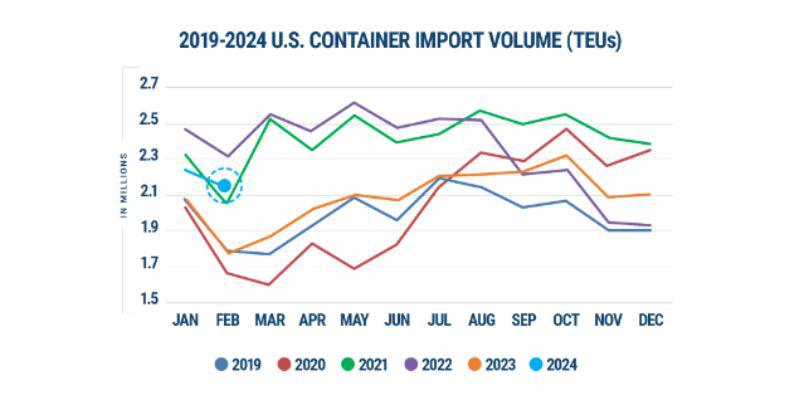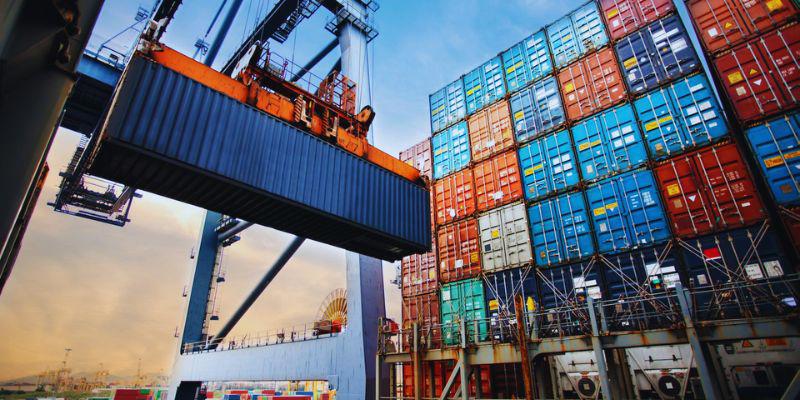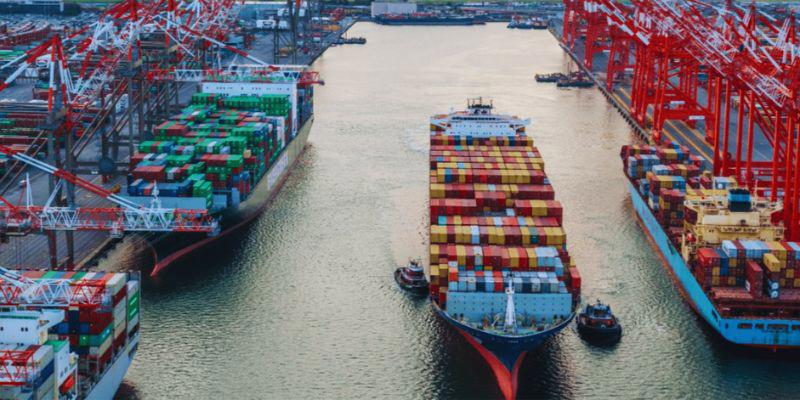
Starting June 1st, 2023 Our warehouse fee will be $0.65/cubic foot per month
In effort to lower the warehouse storage fee during inflation, we have went narrow aisle racking.This construction took us four months but the project is finally completed. With narrow aisle racking, we are able to drop storage by 24%.We as partners will go through this inflation together.
03/25/2024
In February, U.S. container imports surged, surpassing the figures from 2019 for the same period.
Despite a 6.0% decrease in volume compared to January 2024, totaling 2,137,724 twenty-foot equivalent units (TEUs) (refer to Figure 1), imports in February 2024 exceeded those of February 2023 by 23.3% and soared by 19.5% compared to February 2019, before the pandemic.

Several factors likely contributed to this substantial year-over-year growth rate for February. The leap year in 2024 added an extra day to February's capacity. Moreover, China's Lunar New Year fell on February 11 this year, as opposed to January 22 in 2023, resulting in no usual impact on U.S. imports from China for February 2024, unlike February 2023.
To gain a clearer insight into the performance against the previous year, Descartes analyzed TEU volumes in the first 15 days of February for both years, excluding the impact of China's Lunar New Year. During this period, container import growth stood at 13.3%, a significantly more representative figure.
Overall, the data from Figure 1 suggests that the first two months of 2024 align more closely with pre-pandemic growth rates driven by consumer demand.
Port congestion decreased in February across all coasts, although ports on the East and Gulf coasts experienced the longest delays. The economy continues to surpass expectations, indicating robust import volumes. However, challenges such as droughts in Panama, conflicts in the Middle East, and pending ILA contract negotiations at ports in the South Atlantic and Gulf underscore further disruptions in global maritime trade flow.

Promoting import and export in the U.S. market requires a combination of strategies aimed at facilitating trade, reducing barriers, and enhancing competitiveness. Here are some key steps that can be taken:
Negotiating and signing trade agreements with other countries can open up markets and reduce tariffs, making U.S. goods more competitive abroad and encouraging imports.
Improving infrastructure such as ports, roads, railways, and airports can enhance the efficiency of transportation and logistics, reducing costs and facilitating the movement of goods in and out of the country.
Simplifying customs procedures and reducing bureaucratic hurdles can speed up the clearance process for imports and exports, saving time and money for businesses.
Providing support and resources to SMEs can help them overcome barriers to international trade and expand their export capabilities, thus increasing overall trade volume.
Implementing programs that provide market information, trade missions, and export assistance to businesses can help them identify and access new markets for their products and services.
Leveraging technology and innovation in areas such as e-commerce, supply chain management, and digital trade platforms can improve the efficiency and competitiveness of U.S. businesses engaged in international trade.
Providing training and skills development programs for exporters and importers can help them navigate complex international trade regulations, understand market dynamics, and build relationships with overseas partners.
Creating a supportive regulatory environment that promotes trade, protects intellectual property rights, and ensures fair competition can encourage businesses to engage more actively in import and export activities.

Actively seeking to diversify trade partners and markets can reduce dependency on any single market and mitigate risks associated with geopolitical uncertainties or trade tensions.
Offering trade financing options and export credit insurance can help mitigate the risks associated with international trade, making it easier for businesses to engage in importing and exporting activities.
By implementing these measures, policymakers and stakeholders can work together to promote import and export activities in the U.S. market, thereby fostering economic growth, job creation, and prosperity.
Related articles to help you update new information:
👉 Why the Second Half of 2024 looks promising for freight industry
👉 Noticeable Logistics Trends in 2024
👉 Red Sea Region Witnesses a 21% Decline in Cargo Volumes Amidst Rising Ship Attacks
In conclusion, the robust growth in container imports into the United States during February underscores the resilience and dynamism of the country's economy amidst evolving global trade dynamics. This surge in imports reflects not only increased consumer demand and economic recovery efforts but also highlights the adaptability of businesses in navigating challenges within the global supply chain. Moving forward, sustaining this momentum will require continued investment in infrastructure, trade facilitation measures, and support for businesses, particularly small and medium-sized enterprises, to capitalize on emerging opportunities in international trade. By fostering a conducive environment for import and export activities, the United States can further enhance its position as a key player in the global marketplace, driving economic growth and prosperity for years to come. Thank for read the article of WCL.
SEO
Digital Marketing/SEO Specialist
Simon Mang is an SEO and Digital Marketing expert at Wordcraft Logistics. With many years of experience in the field of digital marketing, he has shaped and built strategies to effectively promote Wordcraft Logistics' online presence. With a deep understanding of the logistics industry, I have shared more than 500 specialized articles on many different topics.

Hot News
08/05/2024

Hot News
02/23/2023

Hot News
02/23/2023

Hot News
02/06/2023
Hot News
02/07/2023